3rd March
Just a light easterly breeze; still very cold, with snow flurries throughout the morning c.7km.
Just a light easterly breeze; still very cold, with snow flurries throughout the morning c.7km.
The start of another month so transect surveying is uppermost in my mind as I start off by heading south along the Gowy from the A5117. At 1.75 kilometres this is the longest of the five transects and though primarily for dragonflies it does have its birdy moments.
The first notable species unfortunately couldn’t be included in the transect results as the merlin was dashing eastward beyond what could be called a reasonable distance, It was nonetheless a very good bird for the year and the first addition to the 2018 list for quite a while.
Both mallard and teal were regularly disturbed from the river as I progressed south and by the time I’d reached the motorway, there had been 37 and 96 respectively, both made all the more interesting as there were to be none of each on the main pond later on. A young cormorant fished along the river and a nice flock of 25 goldfinches were the largest flock over recent weeks.
Overhead of course there were constant streams of gulls, almost 1,000 in total but nothing to compare with the clouds attending the landfill just to the south of the motorway. There were so many gulls coming down into the fields I had to go take a look – it was after all just another 150 metres and who knows what there might be. Well, by the time I’d gotten to a place where I could see, there were about 50! There were actually more crows than gulls, so presumably some activity on the landfill had seen all the gulls departing on the off-chance of something to eat!
The second transect passes across the middle of the reserve – three do the same thing but today I’d work the southerly one only. There wasn’t too much for most of the route apart from another 840 gulls overhead and 35 lapwing actually on the deck in amongst the sheep and starlings. The transect runs around the western and northern edges of the main pond and apart from gulls, gulls, gulls there wasn’t too much to impress. Twenty coot were almost invisible amongst them but five (four adults and a first winter) common gulls were standing nicely in a line on the ice.
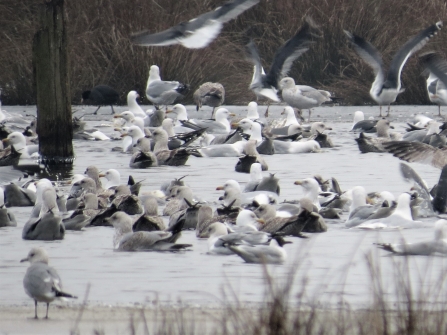
Gulls c. Steve Holmes
The scene was full of activity (see photograph above), with periodic and sudden departures of all gulls for no apparent reason being replaced by more of their kind in a matter of a few minutes.
In the last few metres of the transect I began seeing a few redwing and then noticed more, with starlings, in an adjacent field; on looking through them I also saw perhaps 25 more lapwing – I can’t be absolutely certain as immediately prior to getting to that total a brief flurry of wings from my immediate left proved to belong to a jack snipe! Presumably my being stationary for a while proved too much for it and it typically flew just 25 or so metres before dropping back in to the ditch it had come from.
Feeling I had half a chance of seeing it on the ground for once I readied the camera, pre-set my binocular focus to be the far side of the ditch and gingerly retraced my steps back along it, carefully checking the waters’ edge as I did. Once I was confident I’d gone as far as I needed to, I redoubled my efforts, checking and rechecking both sides of the ditch before shrugging my shoulders and giving up…at which point it immediately took to the air again, heading back from whence it came!! Not seeing actually where it went, that was that, but at least I’d had two excellent views.
The final transect I walked is essentially Speckled Wood Lane and it wasn’t too bad at all despite lacking many passerines. A lovely quartet of bullfinches held one stunning male and at almost the same time a woodcock flew over, immediately followed by a coal tit high up in the tree above my head!
With the business end of the day complete I headed for home but a casual glance into the reserve from the first gate along the road revealed 80 lapwing and a nice, if somewhat distant view of a fox. On the other side of the road the first field held a few winter thrushes and the flock of 75 chaffinches gave up singles of both brambling and reed bunting.
So that was that I thought. Heading home along the busy A5117 I went through the mental ritual of totting up the days’ species list, reaching a creditable 45 given the weather.
My toes needed re-introducing to my feet however so after noting a dozen rooks amongst other corvids, I was in turbocharge mode before an emergency stop was needed through the flushing of another jack snipe from the roadside ditch! Unfortunately, it didn’t come down again that I saw so I had no opportunity for any further views – but cold toes were a distant memory! This was an incredible event when considering that not only is the road busy with speedy traffic of all shapes and sizes, but the footpath is too! A super bird to end an excellent day.
Incidental record.
A little egret flew over the A5117 into the reserve whilst we were on our way home from Sainsbury’s!
Overcast; much warmer than of late; very little wind. c.9km.
Another kick off at the eastern end of Hob Lane again proves fruitful though as with everywhere, wildfowl numbers are declining due to spring being just around the corner.
Just one curlew today but still 30 greylags, a few canadas and three pink-feet – quite possibly the first local patch record for March!
Bird of the lane was probably the nice male reed bunting however, a scarcity around this part of the patch. I’d hoped to see the resident winter thrush flock to the east of the old people’s home, and technically I did, but only in the air – alongside everything else the passing female sparrowhawk was scaring half to death!
Checking out the transmission towers then produced a female peregrine so at least there is a pair in the area if they can find each other.
No little owl but a calling nuthatch made up for it, as did three bullfinches along Speckled Wood Lane plus the almost inevitable jay these days.
I’d brought the scope along to have a gull session so it was disappointing to find that there were virtually no gulls at all today, perhaps 200 in total but half of them at least were stunning adult lesser black-backed.
Walking along a ditch, checking for green sandpiper I inadvertently sneezed, causing a barn owl to flush from the nearby nest box, which is more traditionally used by stock doves! Its escape route took it half way along Speckled Wood Lane so I got wonderful, prolonged views.
Having confirmed no gulls roosting in their usual fields I turned my attentions to a woodcock hunt that was a dismal failure so returned to check out the main pond. It was mainly empty of duck but among what few there were a nice female pintail sat alongside the lone remaining gadwall; she was presumed to be one of the ‘pair’ I’ve been seeing intermittently just about all winter.
I’d visions of completing another transect today but couldn’t decide which one so I crossed the middle of the reserve to get to the Gowy, delaying the decision as long as I could. Another jack snipe burst from cover as only they can and at the river around 50 teal did likewise but in general I wasn’t being overly impressed so opted for the least good transect, that which follows Thornton Brook back to the village.
It was a struggle to make a dozen species but the pair of stonechats brought the day total to 11. There is a regular passage of stonechat through the reserve in March so perhaps this was its beginning. Pausing to count a small flock of redwing at the very end of the transect resulted in a very close encounter with a lovely fox as it crossed the bridge over Thornton Brook, saw me, turned and casually headed back across the bridge!
Glorious sunny day initially before clouding over; very little wind and not cold really. c.9km.
Hob Lane was again rather excellent and produced just the eighth ever three-figure curlew count (100) for the local patch and the first such occurrence since 2011. The back-up cast included the usual suspects that are now firmly greylag (10), canada (18) and pink-footed geese (3), 50 wigeon and another nuthatch. The trio of Pink-feet (originally four) constituted just the third ever in March. In fact, the only other March record concerned two over Elton railway station on 10th March 1998!
With nothing at all from the initial spate of good birds until north of the old people’s home, the only other notebook entries for the entire day all came from Gowy Meadows. I began by sifting through the almost 1,000 –strong roosting flock in the first roadside field north of the home and though there were 100 lesser black-backed, that was pretty much that – but something caused me to re-focus onto a blur in the foreground feeding amid a few crows…curlew! Just the 8th for the reserve and the first since 2013! I tried to photograph it but of course just as the focus was getting somewhere close to sharp a passing van spooked the crows, which spooked the curlew.
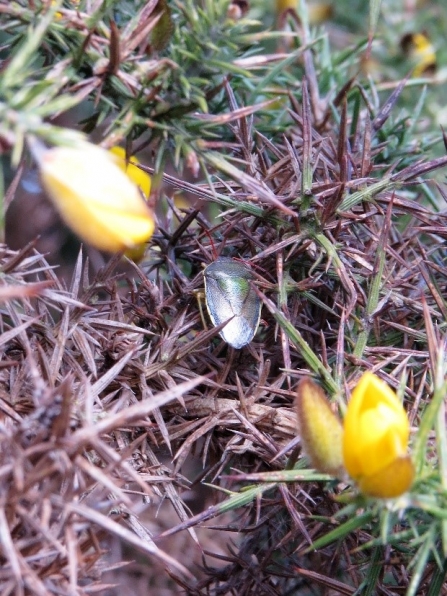
Gorse shieldbug c. Steve Holmes
Anticipation of hearing the first singing chiffchaff was high but the early bird areas all came up blank and the field in SJ4573 only contributed the usual suspects and a fly away cormorant.
Only 175 wigeon from the road could be indicating that some of the flock have gone home but I didn’t have time to check Hob Lane so there may have been more lurking there. Just how quickly things can change was next amply demonstrated by numerous flowering lesser celandines as there had been no sign of them just two days earlier – there was also a lone gorse shieldbug.
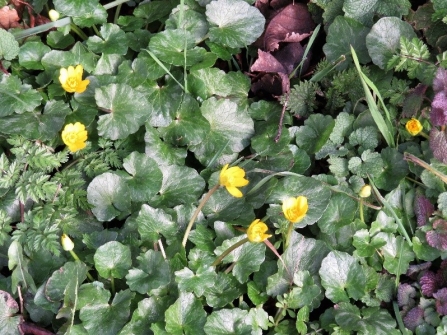
Lesser celandine c. Steve Holmes
Once onto the reserve the drawling wails of a ‘singing’ greenfinch were nice to hear and there would be a second bird later on so hopefully, for such an increasingly rare bird these are good signs that there may be some breeding this year; have to wait to see their lovely display fights before getting too excited though.
Speckled Wood Lane was again vibrating to the song of numerous wrens and a good few redwing flushed away from feeding in the wet ditch. Three grey squirrels and several rabbits did likewise and in truth the latter were nice to see given the outbreak of myxomatosis last year. It seems not to have been a particularly virulent strain and there are once again plenty of animals about.
There are times when you think you must be walking around with your eyes closed as the ‘discovery’ of a sapling oak coated in oak apple galls attests. I couldn’t bring myself to believe I’ve walked past this and not seen it before as it stood out like a sore thumb – I chose to believe that, up until recently, there had been leaves hiding them!
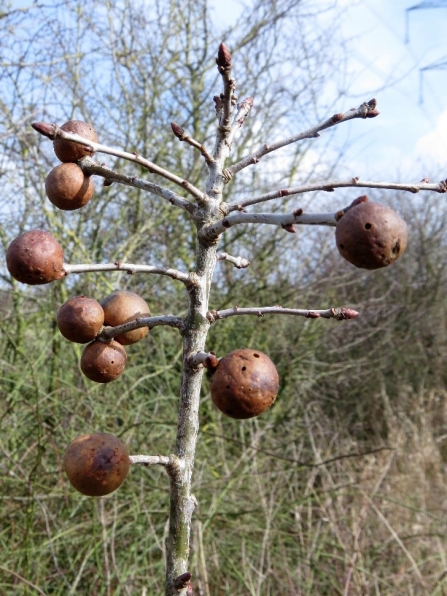
Oak apple galls c. Steve Holmes
The galls, caused by the wasp Biorhiza pallida are quite common on the reserve but I don’t recall seeing so many so close together on a miniscule oak before; some exit holes are clear to see.
Even from a distance on such a windless day, the trilling from a little grebe and bubbling from numerous teal rang loud and clear and subsequently some of the teal were seen to be displaying – not that they will stay to breed; there had been a slight increase in the number of shoveler to around the 30 mark too and several coot were arguing with each other as only coot know how!
My goal for the day had been to see if any more stonechats had turned up as part of their annual passage through the area and up to this point there had been none at all, so it wasn’t looking particularly good.
On moving across the middle of the reserve I just stood for a while to wait for anything that chose to arrive; the first raven for a good while then called from somewhere but I couldn’t see it until it dawned on me that it was actually circling directly above my head!
Something then caused more teal than I’d seen to get up and start hurtling around the skies – there had been some shotguns pooping off for a little while but at clay pigeons to the south of the motorway so surely not the cause of all the commotion… or maybe it was. Whatever the cause, through scanning the skies for what I’d hoped was going to be a decent raptor, I chanced upon a super flock of 60 snipe, which flew straight past me and downed into the sedge surrounds of the main pond; there’s something quite special about big snipe flocks and given that there were just a few more on the remainder of the reserve that I checked, I took these to be birds on the move. One jack snipe continued the species excellent run since the turn of the year, being the eighth sighting.
Five stonechats eventually showed, which would have been residents given their location so I tried the same field that held the eight from two days earlier and there was just one more male…clearly the part of the passage I’d seen…was over!
Nonetheless, that I’d gone to the area turned out to be good news as there were plenty of winter thrushes, particularly redwing (100+) and practically all feeding in another wet ditch along with 40 fieldfare. Two bullfinches, three linnets and a calling chiffchaff completed the picture before I moved to check out the other principal pond for…well, anything really! There was but one snipe in the gooey surrounds, half a dozen teal that skulked into the rushes thinking Id not seen them and a pair of coot alongside eight Canadas.
It’s unlikely that they will all stay to breed, but such an arrival is something else typical of what I am now categorising as early spring’. I’d previously seen another pair in a different area of the reserve so things are looking good that maybe two or three pairs will stick around. In the light rain now falling, two birds posed nicely for their passport photos…
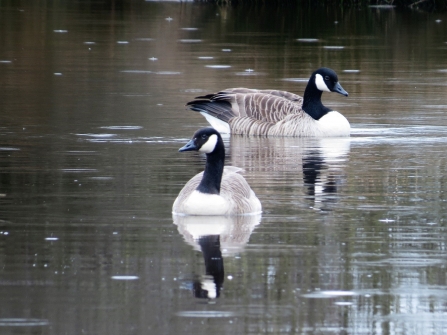
Canada geese c. Steve Holmes
The last birds of consequence were a couple of herons and the third raven of the day headed over and into the oil refinery, hopefully to a nest already built.
Totting up, I’d not thought I’d done that well, but even without seeing rook or common gull, the day tally came to 51.